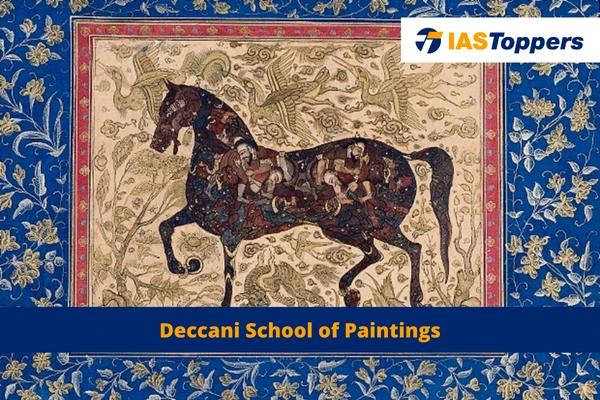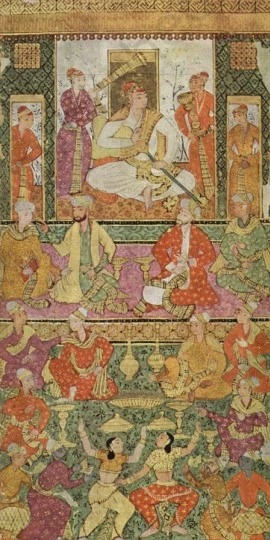The Deccani Schools of Painting, active during the 16th and 17th centuries in Ahmednagar, Bijapur, and Golconda, had unique styles that merged local and Mughal influences. The various styles of Deccani Schools of Painting include Ahmednagar School, Bijapur School, Golconda School, Hyderabad School and Mysore School. In this article, you will know about meaning of Deccani Schools of Painting as well as its various schools such as Ahmadnagar, Bijapur, Golconda, Hyderabad, Tanjore etc, all of which are important for GS Paper-1 Art & Culture of UPSC IAS Exam. To explore more interesting UPSC Art & Culture Class 12 topics like Deccani Schools of Painting, check out other articles and IAS Notes of IASToppers.
Table of Content
- Introduction
- What is Deccani Schools of Painting?
- Ahmadnagar School of Painting
- Bijapur School of Painting
- Golconda School of Painting
- Hyderabad School of Painting
- Tanjore School of Painting
- Mysore School of Painting
- Conclusion
- FAQs on Deccani Schools of Painting
What is Deccani Schools of Painting?
- In the 16th and 17th centuries, centres of Deccani Schools of Painting were primarily located in Ahmednagar, Bijapur, and Golconda.
- Initially, Deccan’s painting evolved independently, but it started exhibiting notable Mughal influences during the 17th and 18th centuries.
Ahmadnagar School of Painting
- The earliest examples of Ahmednagar’s painting can be found in a collection of poems dedicated to Hussain Nizam Shah I of Ahmednagar (1553-1565) and his queen.
- This anthology, called the ‘Tarif-in-Hussain Shahi’ is believed to be created between 1565-69.
- One of its paintings portrays the king on his throne, surrounded by several women. The depiction of the women in the artwork reflects the Malwa tradition of the north, with their clothing and hairstyles.
- The use of vibrant, rich colours stands apart from the northern paintings.
- The Choli (bodice) and long pigtails braided and ending in a tassel were seen in the northern costume.
- This feminine dress, present in a series of Ragamala paintings, are the most striking examples of 16th century Deccan Schools of Painting.
- Male costume is also northern. The jama (coat) with pointed tails is frequently seen in early Akbari miniatures. The small pagri is close to the form found in the earliest Akbari miniatures.
- These paintings also exhibit Persian influences in its depiction of a high horizon, golden sky, and landscape.
- Other notable works from Ahmednagar include the
- Hindola Raga from 1590 A.D., and
- Portraits of Burhan Nizam Shah II of Ahmednagar and Malik Amber.
Bijapur School of Painting
- In Bijapur, these paintings were patronised by Ali Adil Shah I (1558-80 A.D.) and his successor Ibrahim II (1580-1627 A.D.).
- Ibrahim II was author of a book on this subject, Nauras-nama.
- He was the owner of Nujum al-Ulum manuscript and believed to commissioned the Ragamala series in the 1590s.
- An encyclopaedia known as the Najum-al-ulum (Stars of Sciences) was created in 1570 A.D. in the reign of Ali Adil Shah I. This manuscript contains 876 miniatures.
- The painting depicts tall, slender ladies in South Indian dress. The influence of the Lepakshi mural painting can be seen in these portrayals.
- Abundant use of gold colour, some blooming plants, and arabesques on the throne’s top are elements borrowed from Persian art.
- Examples:
- Throne of Prosperity, a diagram of a throne of 7 stages, each supported by elephants, tigers, palm trees etc.
- Yogini, a female who who believes in yoga, and is famous for renunciation of worldly attachments.
Golconda School of Painting
- Earliest paintings accredited to Golconda include a series of five artworks created during Muhammad Quli Quta Shah’s reign (1580-1611).
- All five painted pages are enriched with gold. These paintings show court scenes of a young ruler, who is seated holding a Deccani sword, as well as dancing girls performing for an audience.
- Other Golconda artworks include “Lady with the Myna bird“, a manuscript of a Sufi poem.
- Early Deccani paintings showcased a blend of influences from the northern Malwa tradition, the southern Vijayanagar.
- In late 17th century, Golconda’s art became popular as Dutch merchants carried the portraits of sultans to Europe.
Hyderabad School of Painting
- The origin of painting in Hyderabad coincides with the establishment of the Asafjahi dynasty by Mir Qamruddin Khan Nizam-ul-Mulk in 1724 A.D.
- Deccani paintings of the time began to demonstrate influences from Mughal painting, a development facilitated by the influx of Mughal artists who relocated to the Deccan during Aurangzeb’s reign.
- This led to the evolution of distinct painting styles in Hyderabad and other regions in the 3rd quarter of the 18th century.
- Deccani paintings from the 18th-19th centuries showcased unique attributes in the depiction of ethnic groups, attire, jewellery, plant and animal life, landscapes, and colour palettes.
- An example is a Deccan miniature painting that depicts a princess accompanied by her maids.
Tanjore School of Painting
- Tanjore, located in South India, witnessed the flourishing of a unique painting style during the late 18th and 19th centuries.
- It traces its origins back to the fall of the Vijayanagara Empire and the defeat of the Thanjavur Nayakas by the Marathas.
- Maratha rulers, particularly during the 18th century, gave significant support to Tanjore School of Painting.
- What sets these artworks apart is their creation on unique mediums such as glass and wooden panels, known as Palagai padam, in contrast to the more common usage of cloth and vellum seen in Northern India.
- It is renowned for its bright striking colour schemes, ornamental details and the incorporation of gold leaf.
- It was given recognition of Geographical Indication (GI) by the Indian Government.
- Artisans of this school utilised a variety of gemstones and cut glasses as adornments, producing grandiose imagery.
- The central theme of these paintings often revolved around the smiling Krishna, portraying him in various postures and narrating episodes from his life.
- The art form saw its peak under the reign of Maharaja Serfoji II, a member of the Maratha dynasty who was a notable art enthusiast.
- In recent times, the artists have begun exploring a wider range of subjects, including birds, animals, and architectural structures.
Mysore School of Painting
- Mysore paintings were patronised by the rulers of the Mysore province, a support that persisted even during the British rule.
- It belongs to the time period between 2nd-7th century.
- The origin of both Mysore and Tanjore painting styles can be traced back to the same Vijayanagara school of art. Both styles evolved over time, influenced by the Nayaka style of painting.
- The primary subject matter of these painting was depiction of Hindu gods and goddesses.
- Methods used were significantly different from the techniques used in Northern Indian paintings.
- What sets these artworks apart is the depiction of multiple figures within a single painting, with a dominant figure standing out in terms of both size and colour intensity.
- Mysore artists utilize a unique material known as ‘gesso paste’, a blend of white lead powder, gum, and adhesive, to create a specific base layer for their artworks. This specialized base induces a glossy effect in the backdrop of the painting.
- To balance this luminosity, artists used muted colours that don’t overly brighten the overall aesthetic.
- Other key features are delicate lines, intricate brush strokes, graceful delineation of figures and the discreet use of bright vegetable colours and lustrous gold leaf.
Conclusion
Deccani Schools of Painting, including the Ahmednagar, Bijapur, Golconda, Hyderabad, Tanjore, and Mysore Schools, has various traditions, influences, and innovations in the art, architecture, and paintings of Deccan kingdoms. The Mughal and Deccan School of Miniature Painting beautifully captures the symbiotic relationship of these diverse cultures with local motifs, styles, and techniques along with Persian, Malwa, and Vijayanagara influences.
Ref: Source-1
| Other Articles in History & Culture | |
| Basic Feature of Hindu Temple | Orthodox Schools of Indian Philosophy |
| Kathakali | Kharosthi Script and Gupta Script |
| Guru Nanak | Prehistoric Rock Paintings in India |
FAQs (Frequently Asked Questions)
Where is the origin of deccan school of miniature painting
The Deccan School of Miniature Painting originated in the Deccan Plateau region, notably in the centres of Ahmednagar, Bijapur, and Golconda during the 16th and 17th centuries.
What are the key features of the Deccani Schools of Painting?
The Deccani Schools of Painting are known for their unique fusion of local traditions and Mughal influences, featuring vibrant colors, depictions of northern and South Indian costumes, and often rich gold accents.
What are some famous examples of Deccani Schools of Painting?
Some famous examples of Deccani Schools of Painting include the “Hindola Raga” painting from the Ahmednagar School of Painting, the “Throne of Prosperity” painting from the Bijapur School of Painting and the “Lady with the Myna bird” from Golconda School.








